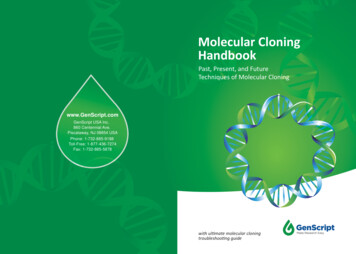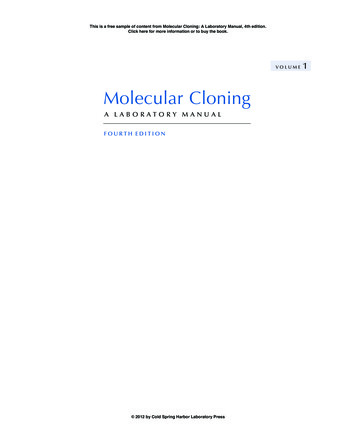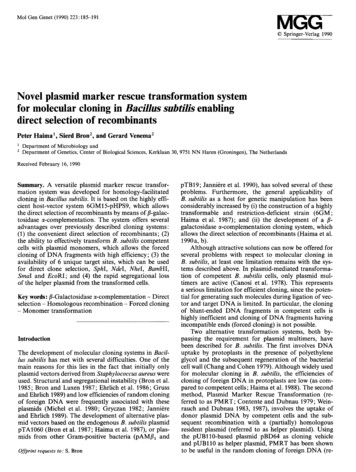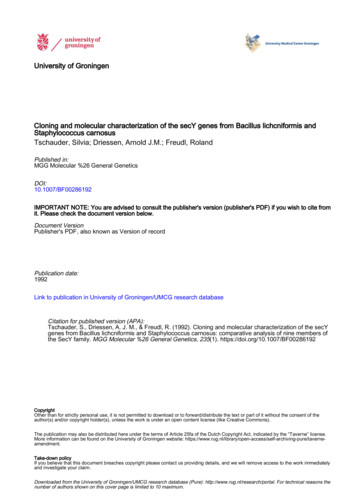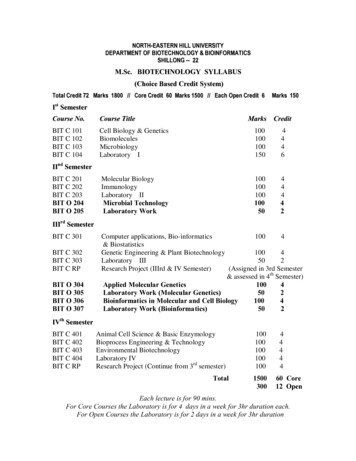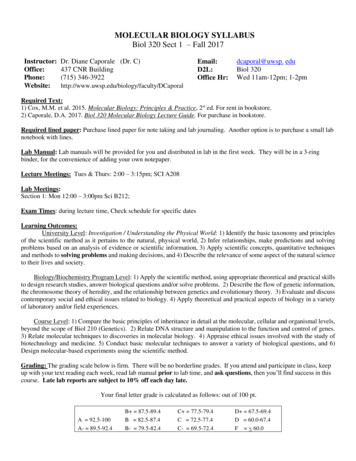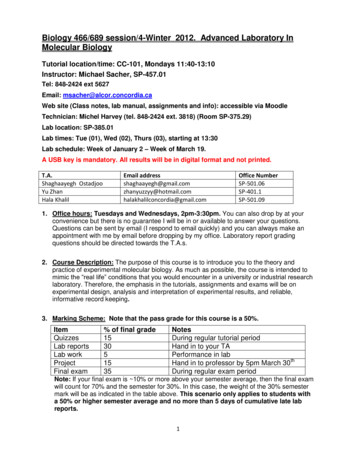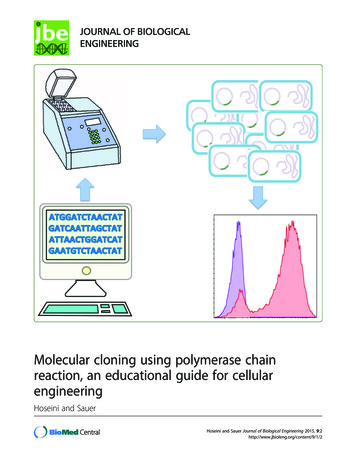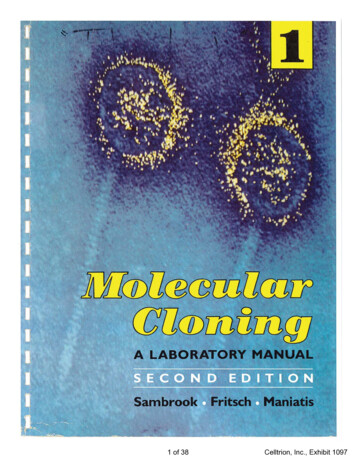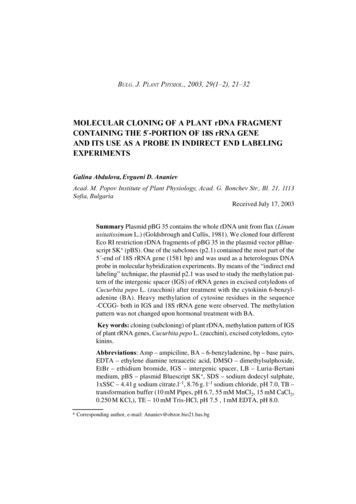
Transcription
BULG. J. PLANT PHYSIOL., 2003, 29(1–2), 21–3221MOLECULAR CLONING OF A PLANT rDNA FRAGMENTCONTAINING THE 5 -PORTION OF 18S rRNA GENEAND ITS USE AS A PROBE IN INDIRECT END LABELINGEXPERIMENTSGalina Abdulova, Evgueni D. AnanievAcad. M. Popov Institute of Plant Physiology, Acad. G. Bonchev Str., Bl. 21, 1113Sofia, BulgariaReceived July 17, 2003Summary Plasmid pBG 35 contains the whole rDNA unit from flax (Linumusitatissimum L.) (Goldsbrough and Cullis, 1981). We cloned four differentEco RI restriction rDNA fragments of pBG 35 in the plasmid vector pBluescript SK (pBS). One of the subclones (p2.1) contained the most part of the5 -end of 18S rRNA gene (1581 bp) and was used as a heterologous DNAprobe in molecular hybridization experiments. By means of the “indirect endlabeling” technique, the plasmid p2.1 was used to study the methylation pattern of the intergenic spacer (IGS) of rRNA genes in excised cotyledons ofCucurbita pepo L. (zucchini) after treatment with the cytokinin 6-benzyladenine (BA). Heavy methylation of cytosine residues in the sequence-CCGG- both in IGS and 18S rRNA gene were observed. The methylationpattern was not changed upon hormonal treatment with BA.Key words: cloning (subcloning) of plant rDNA, methylation pattern of IGSof plant rRNA genes, Cucurbita pepo L. (zucchini), excised cotyledons, cytokinins.Abbreviations: Amp – ampiciline, BA – 6-benzyladenine, bp – base pairs,EDTA – ethylene diamine tetraacetic acid, DMSO – dimethylsulphoxide,EtBr – ethidium bromide, IGS – intergenic spacer, LB – Luria-Bertanimedium, pBS – plasmid Bluescript SK , SDS – sodium dodecyl sulphate,1xSSC – 4.41 g sodium citrate.l–1, 8.76 g. l–1 sodium chloride, pH 7.0, TB –transformation buffer (10 mM Pipes, pH 6.7, 55 mM MnCl2, 15 mM CaCl2,0.250 M KCl,), TE – 10 mM Tris-HCl, pH 7.5 , 1mM EDTA, pH 8.0.* Corresponding author, e-mail: Ananiev@obzor.bio21.bas.bg
22G. Abdulova and E. D. AnanievIntroductionThe nuclear ribosomal RNA (rRNA) genes in eukaryotic organisms constitute a multigene family organized in tandemlly repeated units localized at the sites of nucleolusorganizers (Long and Dawid, 1980). Each repeat unit consists of a noncoding IGSregion situated upstream of the genes coding for 18S, 5.8S and 28S (25S in plants)rRNAs. In spite of the similarity of the overall transcriptional organization in plantsand animals, the plant rRNA genes are different by two main reasons: they are highlyrepeated and the length of the repeated rDNA unit is much shorter than in animals(Long and Dawid, 1980). The great number of rRNA genes in plants is in excess ofthat needed for the cytoplasmic ribosome pool even in case of increased protein synthesis (Flavel et al., 1988). So, it seems likely that the plant cell can control the numberof active rRNA genes via a specific mechanism of discriminating between transcriptionally active and silent rDNA copies. A lot of data on eukaryotic gene expressionshowed that such a control could be exerted through a concerted regulation includingregulation of transcription at chromosome level by alterations of chromatin conformation and changes in the content of methylated cytosine residues on DNA template(Bird, 1995; Razin, 1998). Now it is firmly established that plant genomes contain muchmore 5-methylcytosine (5-mC), (about one third of cytosine) than animal genomes(Gruenbaum et al., 1981). Ribosomal RNA genes in plants seem to be also heavilymethylated (Delseny et al., 1984; Flavell et al., 1988; Torres-Ruis and Hemleben,1994). However some specific sites in the repeated rDNA unit were found to beregularly hypomethylated (Flavell et al., 1988; Jupe and Zimmer, 1990). Special interest deserves the IGS of rRNA genes where the promotor region and transcriptiontermination site (TTS) as well as other repetitive elements are localized and they aresupposed to play an important role in regulation of transcription. Now it is well knownthe primary structure and the methylation pattern of IGS in a single rDNA clone ofC. pepo (zucchini) (King et al., 1993), but little is known about the functional regulation of transcription of these genes under different physiological conditions. The mainobjective of this work was to study the methylation pattern of IGS in zucchini afterhormonal treatment in vivo of excised cotyledons with the cytokinin 6-benzyladenine(BA) when a 2-4-fold stimulation of the endogenous nuclear RNA polymerase I activity was previously observed (Ananiev at al., 1987).In the present work we mapped the methylation of C in the sequence -CCGGwithin the IGS of C. pepo by the use of methylation sensitive restriction enzymes MspI and Hpa II and the “indirect end labeling” technique. Based on the conservatism of18S rRNA genes in eukaryotes we made use of the 5′-end portion of the structuralgene of 18S rRNA from flax (Linum usitatissimum L.) as 32P-labeled rDNA probe.The plasmid pBG 35 which contains the whole rDNA unit from flax served as a donorfor cloning the appropriate rDNA probe (Goldsbrough and Cullis, 1981). Complete
Molecular cloning of a plant rDNA fragment containing the 5′-portion of 18S . . .23digestion of pBG 35 with the restriction enzyme Eco RI results in generation of fourrDNA fragments with different size. The smallest of them (2.1 kb) spans the 5′-endportion of 18S rRNA structural gene and was used as rDNA hybridization probe. Inthis work we describe the cloning procedure of Eco RI 2.1 kb fragment at the singleEco RI site in the polylinker of plasmid pBluescript and its use as rDNA hybridizationprobe.Material and MethodsPlants and growth conditionsSeeds of Cucurbita pepo L. (zucchini), cv. Cocozelle, were germinated for 96 h indarkness at 28ºC. After excision of the embryonic axes, cotyledons were transferredto Petri dishes with distilled water for another 24 h in order to reduce the endogenouscytokinins and abscisic acid content. Then the cotyledons were incubated on distilledwater (control) for 12 h in darkness or on aqueous solutions of 45 µM BA for 6 h indarkness.Isolation of nuclear DNA and purificationPreparation of nucleiCrude nuclei preparation from excised cotyledons was obtained as previously described (Ananiev et al., 1987). Cotyledons were ground in liquid nitrogen or in a mortarwith precooled bufer A (30 ml buffer per 5 g of plant material). Buffer A contained20 mM Tris-HCl, pH 8.0, 10 mM MgCl2, 20 mM KCl, 0.6 M sucrose, 30% glycerol,0.5 mM EDTA and 10 mM 2-mercaptoethanol. 400 µg.ml–1 ethidium bromide (EtBr)was present in the grinding buffer as an inhibitor of endogenous DNase and RNaseactivities (Luthe and Quatrano, 1980). The homogenate was filtured through Miraclothand centrifuged at 3000 rpm at –5 ºC for 10 min.Nuclear DNA extractionThe nuclear pellet was lysed in a buffer containing 100 mM Tris-HCl, pH 8.0, 1% SDSand 20 mM EDTA. DNA was extracted by gentle shaking in ice-cold water bath overnight, purified by subsequent deproteinization with phenol (2 times), phenol-chloroform and chloroform:isoamilyc alcohol (24:1), precipitated with 3 vol. ethanol anddissolved in TE buffer. Total cellular RNA was digested with RNase A (10 µg. ml–1)according to Maniatis et al., 1982. DNA was purified by thorough deproteinizationwith phenol (at least 2 times), phenol-chloroform and chloroform:isoamilyc alcohol(24:1), precipitated with 3 vol. of ethanol and dissolved in TE buffer.
24G. Abdulova and E. D. AnanievMolecular cloning of plant rDNA fragmentsPreparation of competent cells of E. coliAll medias used throughout the experiments were prepared according to the procedureof Hanahan (1983). Competent for transformation cells of E. coli strain XL1-blue wereprepared according to Okayama et al., 1990 with slight modifications. LB agar plates(containing 12.5 µg ml–1 tetracycline) were inoculated with thawed XL1-blue cellsin Hogness medium (3.6 mM K2HPO4; 1.3 mM KH2PO4, 2 mM Na-acetate, 1 mMMgSO4.7H2O, 4.4% glycerol) and cultivated overnight at 37 ºC. Two or three colonies(2–3 mm in diameter) were used to inoculate 100 ml of SOB medium (Bacto Tryptone– 20 g.l–1, yeast extract – 5 g.l–1, NaCl – 0.5 g.l–1, 10 mM MgCl2, 10 mM MgSO4,2.5 mM KCl) in 500 ml flasks and grown to an absorbtion A600 of 0.6 at 18 ºC withvigorous shaking (200–500 rpm). The cell culture was centrifuged at 3000 rpm for10 min at 4 ºC and the cell pellet was resuspended in 32 ml of precooled transformationbuffer (TB). The cells were incubated in an ice bath for 10 min and spun down asabove. The pellet was gently resuspended in 8 ml of TB, containing DMSO at finalconcentration of 7%. After incubation on ice for 10 min the cell suspension wasdivided to 1 ml into 1.5 ml Eppendorf tubes and kept at –70 ºC until used.Transformation of competent cellsFrozen competent cells of E. coli (50 µl), strain XL-1 blue with genotype: F, proAB,lac Iq, lac ZDM15, Tn 10 (Tetr), rec A1, gyr A96 (Na Ir), thi 1, sup E44, rel A1, werethawed in an ice bath. After that plasmid DNA was added in 1–5 µl (1 ng.ml–1) to thecells and the mixture was swirled and incubated on ice for 30 min. The mixture washeat-pulsed without agitation at 42 ºC for 30 s and placed on ice for 10 min. Then500 µl of LB medium were added and the tubes were incubated at 37 ºC for 1 h. LBagar plate (containing 100 µg.ml–1 Amp) was inoculated with 100 µl of the cell cultureand cultivated overnight at 37 ºC.Plasmid DNA isolation (“maxi-prep”)70 ml of LB medium (Bacto Tryptone – 10 g.l–1, yeast extract – 5 g.l–1, NaCl – 10 g–1),containing 100 µg.ml–1 Amp, were inoculated with a single colony obtained after transformation of competent cells of E. coli. Cells were cultivated overnight at 37 ºC withvigorous shaking (200–250 rpm). The cell culture was pelleted at 5000 rpm for 10 minat 4 ºC. The cell pellet was resuspended in 4 ml solution I (50 mM glucose, 50 mMTris-HCl, pH 8.0, 10 mM EDTA) and incubated in an ice bath for 10 min. 4 ml of solution II (0.2 N NaOH, 1% SDS) were added. After incubating in an ice bath for 10 min4 ml of potassium acetate (pH 5.0) was added to the suspension and incubated on icefor another 10 min. After that 10–12 ml of chlorophorm/isoamyl alcohol (24:1, vol/vol)was added. Samples were centrifuged at 5000 rpm for 10 min and the supernatant wastreated with RNase A (final concentration of 0.025 mg.ml–1) for 1 h at 37 ºC. Afterthat the supernatant was purified by several steps of deproteinization with phenol/chloro-
Molecular cloning of a plant rDNA fragment containing the 5′-portion of 18S . . .25phorm (1:1, vol/vol) and chlorophorm/isoamyl alcohol (24:1 vol/vol) and then precipitated with equal volume of ispropanol. The precipitate was washed once with 70%ethanol, dried and finally dissolved in TE buffer (10 mM Tris-HCl, pH 7.5, 1 mMEDTA). Plasmid DNA was precipitated once more by equal volume of 15% PEG (Mw8 000) and 0.8 M NaCl. After incubation in an ice bath for 1 h the samples were centrifuged in an Eppendorf microfuge (12000 g). The resulting precipitate was washedin 70% ethanol, dried and redissolved in TE buffer.Molecular cloning of rDNA fragments from the repeated rDNA unit of flax andpreparation of rDNA containing plasmidsPlasmid DNA pBG 35 containing the entire rDNA unit from flax (Linum usitatissimumL.) was digested to completion with the restriction enzyme Eco RI (1 µg DNA/5 unitsof enzyme) and the resulting four definitive DNA fragments were separated by a prolonged electrophoresis in 0.8% agarose gel. The appropriate gel strips, containing thefour DNA fragments with lengths of 4.4, 3.05, 2.8 and 2.1 kb were cut with a scalpelfrom the gel, put into an Eppendorf tubes and frozen at –20ºC overnight. After thawingat room temperature the gel strips were homogenized with Vortex and an equal volumeof Tris-HCl-saturated phenol, pH 7.6 was added to the slurry. The mixture was frozenat –55 ºC for 2 h, thawed, vortexed and frozen once again at –20 ºC for overnight. Thewater phase was collected after centrifugation of the thawed material and an equalvolume of phenol was added. The appropriate DNA fragment was pelleted with 2 Mammonium acetate and 1 volume of isopropanol, washed in 70% of ethanol and redissolved in TE buffer. The extraction of DNA fragments from the gel was controlledby electopghoresis in an agarose gel.Alkaline phosphatase treatment of plasmid vector DNA and ligation of DNAfragmentsBriefly, 100 ng of Eco RI-digested pBS was treated with alkaline phosphatase (2 units)in dephosphorilation buffer containing 20 mM Tris-HCl, pH 8.0, 10 mM MgCl2 at37 ºC for 40 min. Alkaline phosphatase was inactivated by heating for 15 min at 65 ºC.Dephosphorilated and linearized pBS-Eco RI plasmid was electrophoretically purifiedin 0.8% agarose gel and extracted from the gel as described above. After that 100 ngof dephosphorilated Eco RI-digested pBS was mixed with 100 ng Eco RI 2.1 kb fragment isolated from the gel. DNA fragments were ligated using 5 units of T4 DNAligase. Ligation reaction was carried out in 10 mM Tris-HCl, pH 8, 10 mM MgCl2,10 mM DTT, 0.5 mM ATP for 16 h at 16ºC. After incubation the ligation mixture wasused to transform competent cells of E. coli, strain XL1-blue. Transformants werescreened visually by α-complementation for blue/white colour selection of recombinants in medium containing 100 µg.ml–1 ampiciline. The structure of recombinantplasmids was then verified by restriction analysis of minipreparations of plasmidDNA.
26G. Abdulova and E. D. AnanievRestriction enzyme analysis and molecular hybridizationSingle or double digests of purified DNA were carried out with restriction enzymesEco RI, Hind III, Msp I or Hpa II (1 µg DNA with 2–5 units of enzyme) according tothe supplier,s instructions. All restriction enzymes used in this work and the DNAmarkers (1 kb DNA ladder and λ-phage DNA digested with Eco RI and Hind III) werepurchased from FERMENTAS, Riga, Lithuania. Restriction enzyme digests of nuclearDNA were electrophoreticaly separated in 0.8% agarose gel and transferred to nylonmembranes (Hybond N ) according to standard methods as described by Maniatis etal., 1982 As a hybridization probes was used the cloned 2.1 kb Eco RI fragment ofpBG35 spanning the 18S rRNA gene in flax (Linum usitatissimum L.). The rDNAprobe was labeled with α[32P]dCTP by the method of “random priming” using hexanucleotides as primers. Hybridizations were carried out at 42 ºC in 5xSSC, 50 mMphosphate buffer pH 6.8, 5% SDS and 50% formamide. Nylon membranes were washed 3 times each in 2xSSC, 50 mM phosphate buffer pH 6.8, 1%SDS; in 1xSSC, 50 mMphosphate buffer pH 6.8 and finally in 0.1xSSC, 50 mM phosphate buffer pH 6.8, 1%SDS at room temperature. Membranes were then dried and exposed to AGWA filmsusing intensifying screens (Du Pont) for 6–24 h at –70 ºC.Results and discussionIn order to subclone the most part from the 5′-end of 18S rRNA structural gene weused as a donor the plasmid pBG 35 which contained the whole rDNA unit from flaxinserted into the plasmid pAT 153 at its single Bam HI site (Goldsbrough and Cullis,1981). Complete digestion of pBG 35 with Eco RI results in generation of four DNAfragments with sizes of 4.4, 3.05, 2.8 and 2.1 kb pairs, respectively. Fig 1. shows thebehaviour of the donor plasmid pBG 35 in the agarose gel (lane 1), the migration ofthe four Eco RI–generated restriction fragments of pBG (lane 2) and the case wheneach of them was extracted from the gel and put to electrophoresis (lanes 3–6). It mustbe noted the purity of the bands corresponding to the fragments with 4.4 and 2.1 kb,respectively, (Fig. 1, lanes 3 and 6) as well as the cross-contamination of the fragmentswith similar size (3.05 and 2.8 kb), (lane 4). The electrophoretic pattern of the recipientplasmid pBS in its three forms (supercoiled, circular and relaxed) is shown in lane 7while its linearized form after Eco RI digestion is presented in lane 8. The electrophoretic pattern of plasmid p2.1 containing the inserted 2.1 kb fragment in pBS is shownin lane 9. Complete digestion with Eco RI of p2.1 resulted in the appearance of twofragments with size of 2.1 and 2.96 kb (the linearized size of pBS) (lane 10). This experimental approach was applied also for the checking of plasmids p2.8 and p4.4 (lanes11–12 and 13–14, respectively). We do not show the proper orientation of the insertedEco RI fragments in the recipient plasmid pBS which is not of critical importance for
27p4.4 Eco RIp2.8 Eco RIp4.43.052.82.1pBSpBS Eco RIp2.1p2.1 Eco RIp2.8pBG 35 Eco RI4.4kb MpBG 35Molecular cloning of a plant rDNA fragment containing the 5′-portion of 18S . . .23.09.46.54.32.32.0123 4 56 789 10 11 12 13 14Fig. 1. Cloning of different fragments from the rDNA unit of L. usitatissimum L. in the plasmid pBluescript SK . Plasmid pBG 35 harbouring the whole rDNA unit of flax was digested with Eco RI andthe resulting fragments were electrophoretically separated in 0.8% agarose gel, isolated from the geland cloned at the single Eco RI site in the polylinker of pBluescript SK as described in “Material andmethods”. M – marker DNA (λ-phage DNA digested with Hind III). Electrophoretic behaviour ofnondigested (Lane 1) and Eco RI-digested pBG 35 (Lane 2). Lanes (3-6) – electrophoresis of the fourEco RI-generated fragments of pBG 35 isolated from the gel (4.4, 3.04, 2.8 and 2.1 kb, respectively).Electrophoretic pattern of the circular (Lane 7) and linearized form of the recipient plasmid pBS afterEco RI digest (Lane 8). Electrophoretic pattern of subclones p2.1 (Lane 9), p2.8 (Lane 11) and p 4.4(Lane 13). Lanes 10,12, and 14 represent the electrophoretic pattern of p2.1, p2.8 and p4.4 sublonesafter a complete Eco RI digestion.our objectives. So, as a result of these cloning experiments we dispose of differentspecific rDNA probes for molecular hybridization.Further on we made use of the plasmid p2.1 to investigate the methylation patternin IGS of the rRNA genes in C. pepo (zucchini). The full nucleotide sequence of IGS
28G. Abdulova and E. D. Ananievin a single rDNA clone of C. pepo is now well known (King et al., 1993). Based onthe sequence data as well as on the conservatism in the primary structure of 18S rRNAgenes in dicots, (GenBank AF223066, 14531 bp of of Humulus lupulus rDNA), werepresented a combined physical restriction map of rDNA unit in C. pepo (Fig 2). C.pepo (zucchini) has two different types of repeated rDNA units with length of about10 and 9.3 kb (Ganal and Hemleben, 1986). Except the length heterogeneity due todifferent repetitive elements in IGS, sequence heterogeneity of rDNA is also observed.Thus, the major repeat unit ( 10 kb) consists of two subtypes that could be distinguished by the presence of an additional Hind III site in front of the 18S rRNA gene. Therefore, complete digestion of the major rDNA unit with Hind III results in two definitefragments of 10 kb and 2.2 kb, while digestion with Eco RI generates two main DNAfragments of 6.2 kb and 3.7 kb from the major unit and a slight 5.7 kb fragment fromthe minor repeat units (Ganal and Hemleben, 1986). The bigger Eco RI fragments contain the IGS itself and can be used to study the methylation of cytosine residues in CpG- met in the regulatory regions of IGS using digestion with the methylation-sensitive restriction enzymes Msp I/Hpa II. In addition, double digestion of genomic DNAwith Eco RI and Hind III will further facilitate this investigation. Methylation of theC residues in the short palindrome -CCGG- can be best studied by the pair of isoschizomers Msp I and Hpa II which have different specificity with respect to methylation. Both enzymes and only Hpa II can cut unmethylated cytosine sequences whileMsp I cuts sites methylated on the second C but not those methylated on the first. Ifboth Cs are methylated, neither enzyme is able to cut the sequence. Indicated in Fig. 2IGSHind IIIEco RIEco RIHind IIIEco RITTS18 S(Hind III)TIS TIS25 S18 S25 SMsp I/Hpa II6.2 kb3.7 kbFig. 2. Restriction map of rDNA unit in excised cotyledons of Cucurbita pepo L. (zucchini). The majorlength variant of rRNA genes ( 10 kb) determined after digestion with Hind III is presented. In bracketsis presented the minor Hind III site in IGS. IGS – intergenic spacer; TIS – transcription initiation site;TTS – transcription termination site. Nuclear DNA was subsequently digested with Eco RI, Hind IIIand afterwards with Msp I or Hpa II, respectively. The length of Eco RI-generated restriction fragmentsand the positions of Msp I/Hpa II sites in IGS and the structural gene for 18S rRNA are indicated.
Molecular cloning of a plant rDNA fragment containing the 5′-portion of 18S . . .29are the positions of all six putative Msp I/Hpa II sites in the IGS as revealed from theprimary structure of one single rDNA clone (King et al., 1993). Based on theconservatism of the structural gene for 18S rRNA the positions of all possible 10 MspI/Hpa II sites in the 18S rRNA gene are also shown. Hind III and Eco RI single anddouble digests of bulk DNA isolated from control and BA-treated cotyledons areshown in Fig. 3A, lanes 2,3,4 and 8,10. Further on, the Eco RI and Hind III-digestionfragments and the position of the active Msp I and Hpa II sites within IGS were precisely located, following Southern transfer to Hybond membrane and hybridizationwith the 32P-labelled 2.1 kb Eco RI fragment subcloned in p2.1 (Fig. 3B). As expectedthe complete digestion of genomic DNA with Hind III resulted in two fragments hybridizing with the 18S rDNA probe (Fig. 3B, lanes 2, 8). The bigger one (10 kb) represents the whole length of rDNA unit in marrow and is generated by the single conservative (present in all rDNA units) Hind III site localized in the internal transcribedspacer 1 (ITS1), 128 bp after the 3′-OH end of the 18S rRNA gene (Jobst et al., 1998).The smaller Hind III fragment (2.2 kb) is defined by the presence of an additionalHind III site in some of the repeats at position 264, upstream from the 5′-end of 18SrRNA gene. In the case of Eco RI digestion only the bigger Eco RI fragments fromthe major and minor rDNA units were detected in autoradiographs as 6.2 kb and 5.7 kb,respectively (Fig. 3B, lanes 3,9). Double digestion with Eco RI and Hind III preservedthe bigger Eco RI fragments but provoked also the appearance of a new fragment of1.845 kb (Fig. 3B, lanes 4,10). The latter fragment was generated when additionalHind III site in IGS appeared as a result of substitution of the outer C in the sequence-AAGCTC- with T, thus generating the proper site for Hind III (-AAGCTT-) in frontof the 5′-end of 18S rRNA gene. Digestion with Msp I resulted in generation of fragments with smaller size (between 0.5 and 2.5 kb), but they were not completely digested with Msp I (Fig. 3B, lanes 5,11). This suggests that in addition with -CpG- sequences,methylation in -CpNpG- might not be random throughout the IGS and 18S rRNA genein marrow. Among the Msp I fragments three of them hybridized most intensively withthis probe thus suggesting that they were generated from the structural 18S rRNA geneitself. Their relative length was estimated to be about 450–500 bp for the smallest one,about 750 bp for the middle-sized and about 1100–1200 bp for the greatest of them(Fig. 3B, lanes 5,11). Special interest deserved the highest Msp I fragment in the electrophoretic pattern since it was also detected after Hpa II digestion. This Hpa II/Msp Imajor fragment was 2.4–2.5 kb long (Fig. 3B, lanes 5,11). By calculating the lengthof all possible Msp I/Hpa II fragments generated from 6.2 kb Eco RI fragment and byoverlapping their lengths it was possible to suggest that these Hpa II fragments couldreside from the group of hypomethylated -CCGG- sites near the second TIS in theIGS. The major Hpa II-generated fragment could arise from a hypomethylated sitelocated 313 bp downstream from the “spacer” promotor and the Hpa II site at position1118 in the 18S rRNA gene. So, it appears that a hypomethylated -CCGG- site couldexist also in the 18S rRNA gene.
30G. Abdulova and E. D. AnanievBp2.1 (18S rRNA)dH2O DNAHind IIIEco RIE HE H Msp IE H Hpa IIBA DNAHind IIIEco RIE HE H Msp IE H Hpa IIkb MEtBrdH2O DNAHind IIIEco RIE HE H Msp IE H Hpa IIBA DNAHind IIIE HE H Msp IE H Hpa IIAM23.09.46.54.310.03.02.32.01.00.51 2 3 4 5 6 7 8 10 11 1212 3 4 5 67 8 9 10 11 12Fig. 3. Methylation pattern of rDNA in excised C. pepo cotyledons. A – Restriction enzyme analysis ofgenomic DNA with indicated enzymes and fluorescence of EtBr-stained DNA fragments in UV-light.B – Hybridization with cloned 32P-labelled 2.1 kB Eco RI fragment (p2.1) spanning the 18S rRNA genefrom flax (Linum usitatissimum L.). Lanes (1–6) – genomic DNA from control cotyledons (dH2O-treatedfor 12 h in darkness). Lanes (7–12) – genomic DNA from BA-treated cotyledons for 6 h in darkness.It must be noted that the methylation patterns of IGS and 18S rRNA gene werenot altered in the case of 2-4 fold stimulated transcription of rRNA genes after in vivotreatment with BA (Fig. 3B, lanes 11,12).Conclusions1. The plasmid pBG 35 which harbors the whole rDNA unit of flax (Linum usitatissimum L.) was used as a donor for cloning different Eco RI-generated fragmentsin the plasmid pBluescipt SK . One of these clones (p2.1) contained a 2.1 kb insertwhich spans the most part of the 5′-end portion of the structural gene for 18SrRNA.
Molecular cloning of a plant rDNA fragment containing the 5′-portion of 18S . . .312. Digestion of genomic DNA with methylation sensitive restriction enzymes Msp Iand Hpa II showed heavy methylation of rRNA genes in C. pepo L. As judgedfrom the almost total lack of digestion with Hpa II, in rDNA units there are nomethylation free regions or little if any were observed. A hypomethylated Hpa IIsite was detected in IGS near the promoter region of some of the repeats.3. The methylation pattern in the IGS and 18S rRNA structural gene was not changedupon in vivo treatment of the cotyledons with cytokinin. This suggested that thealterations in rRNA gene activity were not due to or accompanied by significantDNA methylation changes.Acknowledgement: The authors thank Dr. L. Karagyozov from the Institute of Molecular biology in Sofia for providing the plasmid pBluescript SK and for his usefulsuggestions.ReferencesAnaniev, E. D., L. K. Karagyozov, E. N. Karanov, 1987. Effect of cytokinins on ribosomal RNAgene expression in excised cotyledons of Cucurbita pepo L. Planta, 170, 370–378.Bird, A., 1995. Gene number, noise reduction and biological complexity. Trends Genet., 11,94–100.Delseny M., M. Laroche, P. Penon, 1984. Methylation pattern of radish (Raphanus sativus)nuclear ribosomal RNA genes. Plant Physiol., 76, 627–632.Flavel, R. B., M. O,Dell, W. F. Thompson, 1988. Cytosine methylation of ribosomal RNAgenes and nucleolus organizer activity in wheat. J. Mol. Biol., 204, 523–534.Ganal, M., V. Hemleben, 1986. Comparison of ribosomal RNA genes in four closely relatedCucurbitaceae. Plant Syst. Evol., 154, 63–77.Goldsbrough, P. B., C. A. Cullis, 1981. Characterization of the genes for ribosomal RNA inflax. Nucl. Acids Res., 9, 1301–1309.Hanahan, D., 1983. Studies on transformation of Escherichia coli with plasmids. J. Mol. Biol.,166, 557–580.Inoue, H., H. Nojima, H. Okayama, 1990. High efficiency transformation of Escherichia coliwith plasmids. Gene, 96, 23–28.Jobst, J., K. King, V. Hemleben, 1998. Molecular evolution of the internal transcribed spacer(ITS1 and ITS2) and phylogenetic relationships among species of the family Cucurbitaceae. Mol. Phylogenet. Evol., 9, 204–219.Jupe, E. R., E. A. Zimmer, 1990. Unmethylated regions in the intergenic spacer of maize andteosinte ribosomal RNA genes, Plant Mol. Biol., 14, 333–347.King, K., R. A. Torres, U. Zentgraf, V. Hemleben, 1993. Molecular evolution of the intergenicspacer in the nuclear ribosomal RNA genes of Cucurbitaceae. J. Mol. Evol., 36,144–152.
32G. Abdulova and E. D. AnanievLong, E. D., I. B. Dawid, 1980. Repeated genes in eukaryotes. Ann. Rev. Biochem., 49,727–764.Luthe, D. S., R. Quatrano, 1980. Transcription in isolated wheat nuclei. I. Isolation of nucleiand elimination of endogenous ribonuclease activity. Plant Physiol., 65, 305–308.Maniatis, T., E. F. Fritsch, J. Sambrook, 1982. Molecular cloning, A laboratory manual. ColdSpring Harbor Laboratory Press, Cold Spring Harbor, NY.Razin A., 1998. Cytidine methylation, chromatin structure and gene silencing – a three wayconnection. The EMBO J., 17, 4905–4908Torres-Ruis R. A., V. Hemleben, 1994. Pattern and degree of methylation in ribosomal RNAgenes in Cucurbita pepo L. Plant Mol. Biol., 26, 1167–1179.
according to Maniatis et al., 1982. DNA was purified by thorough deproteinization with phenol (at least 2 times), phenol-chloroform and chloroform:isoamilyc alcohol (24:1), precipitated with 3 vol. of ethanol and dissolved in TE buffer. Molecular cloning of a plant rDNA fragment containing the 5′-portion of 18S . . .
